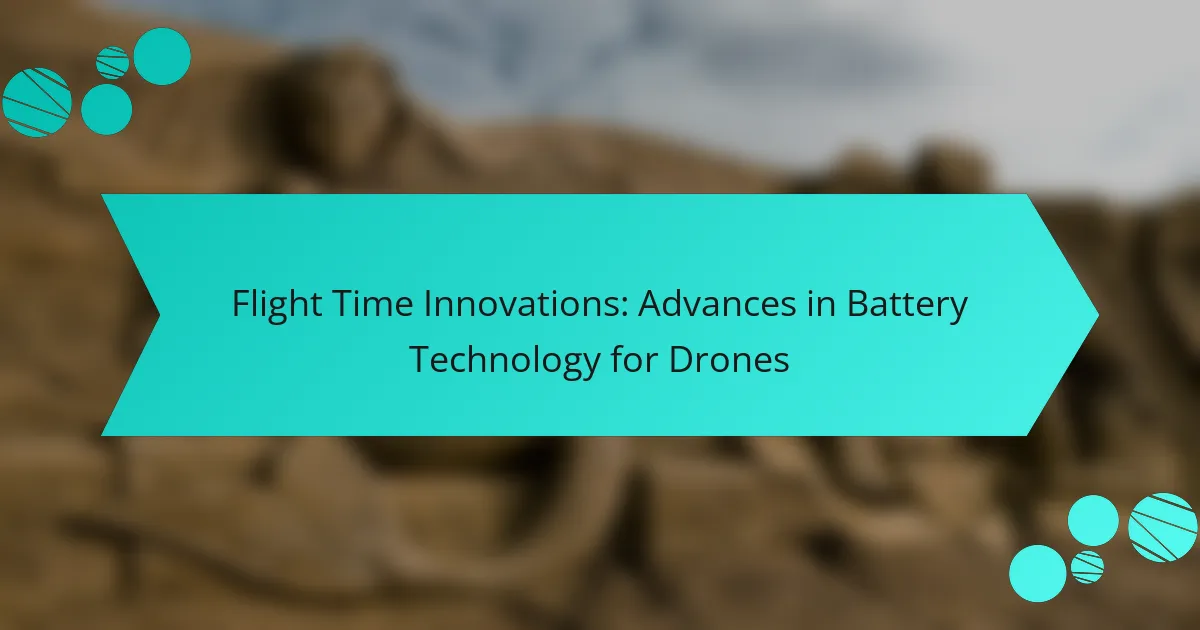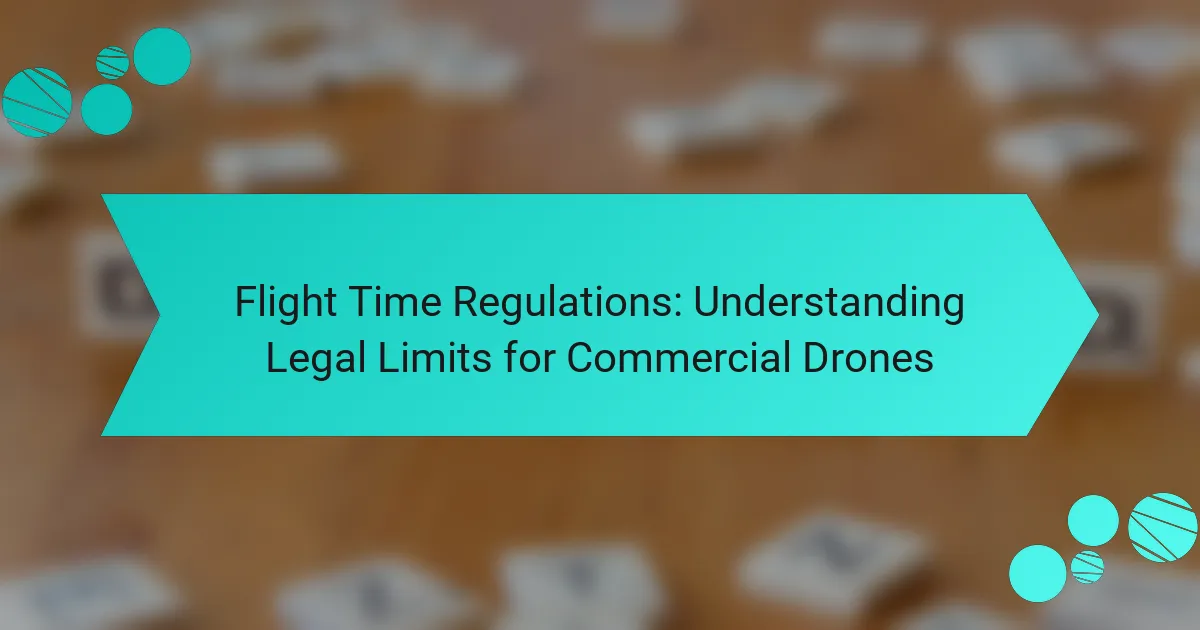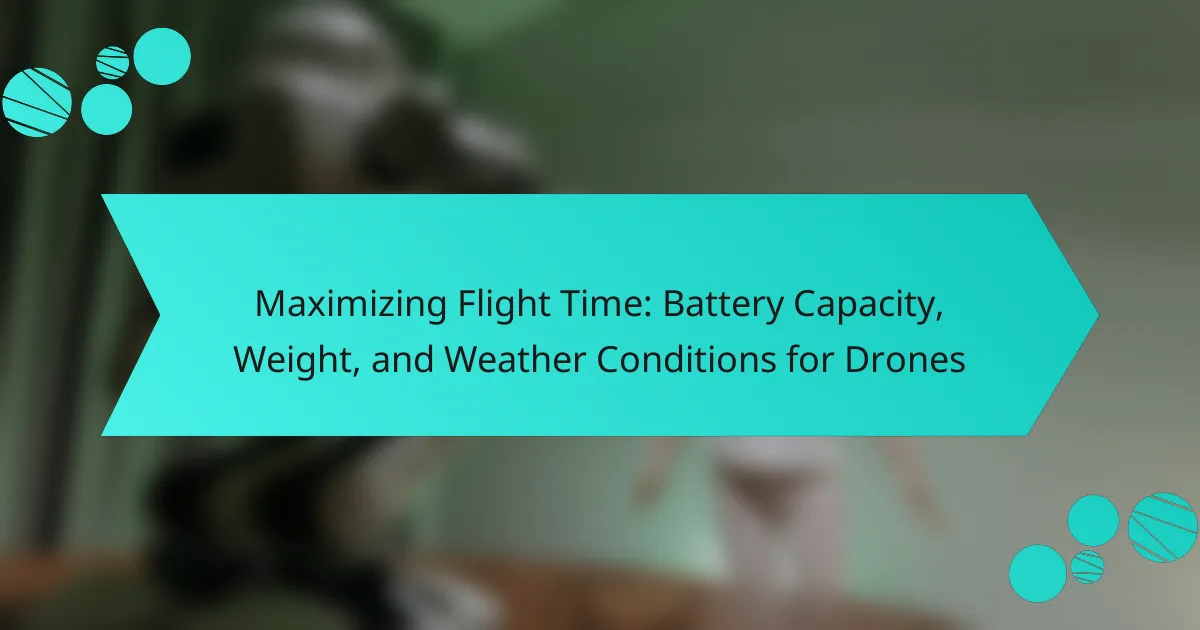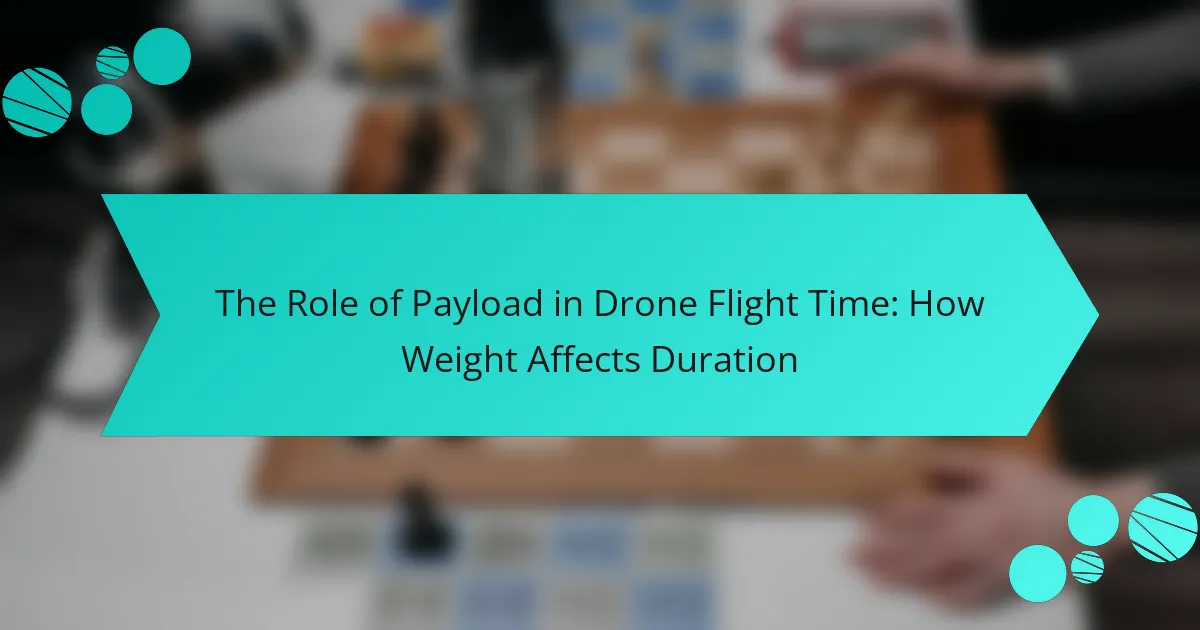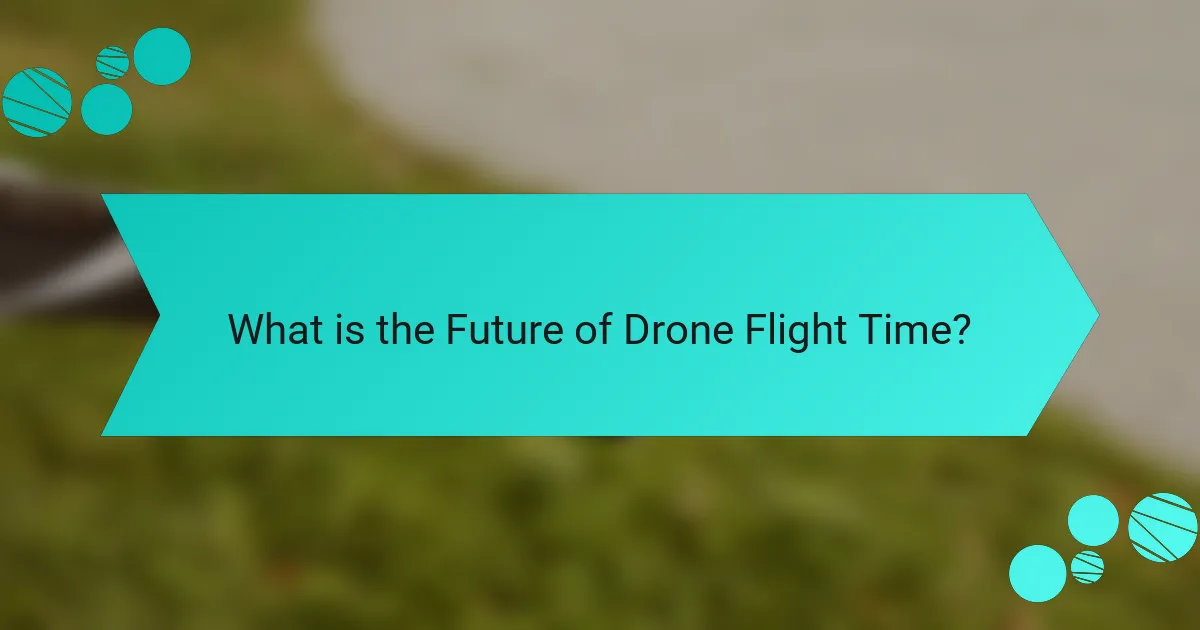
What is the Future of Drone Flight Time?
The future of drone flight time is expected to significantly increase due to advancements in battery technology and energy efficiency. Current consumer drones typically have a flight time of 20 to 30 minutes. However, new developments in lithium-sulfur batteries may extend this duration to over an hour. Research indicates that improvements in aerodynamics and lightweight materials will also contribute to longer flight times. For instance, hybrid drones combining electric and fuel-based systems could achieve even greater durations. Companies are investing in these technologies to enhance drone capabilities for various applications, including delivery and surveillance. Overall, the future holds promising advancements that could revolutionize drone flight time.
How is drone flight time currently measured?
Drone flight time is currently measured using onboard timers and battery management systems. These systems track the duration of flight from takeoff to landing. Additionally, manufacturers provide specifications on estimated flight times under optimal conditions. Factors such as payload weight and environmental conditions can affect actual flight time. For example, a drone may have a specified flight time of 30 minutes but may only achieve 20 minutes in windy conditions. Battery life indicators also help users gauge remaining flight time. Advanced drones may utilize GPS and telemetry data for more accurate measurements. Overall, the combination of timers, specifications, and environmental factors informs users of drone flight time.
What factors influence the duration of drone flights?
The duration of drone flights is influenced by several key factors. Battery capacity is a primary determinant, as larger batteries typically provide longer flight times. The weight of the drone also affects duration; heavier drones consume more power. Flight speed plays a role; faster speeds can reduce total flight time. Environmental conditions, such as wind and temperature, impact battery efficiency and performance. Payload weight, including cameras or sensors, can decrease flight duration. Additionally, the drone’s design and aerodynamics influence energy consumption. Lastly, the type of propulsion system used can vary in efficiency, affecting overall flight time.
How do battery capacity and weight affect flight time?
Battery capacity and weight significantly affect flight time. Higher battery capacity allows drones to store more energy, resulting in longer flight durations. For example, a drone with a 5000 mAh battery can typically fly longer than one with a 3000 mAh battery. Conversely, increased weight from a larger battery can reduce flight time. Heavier drones require more energy to maintain lift, which can lead to shorter flight durations. Studies show that every additional 100 grams of weight can reduce flight time by approximately 10-15%. Thus, optimizing battery capacity while minimizing weight is crucial for maximizing flight time in drones.
What emerging technologies are shaping drone flight time?
Emerging technologies shaping drone flight time include advanced battery systems, energy-efficient propulsion, and artificial intelligence. Advanced battery systems, such as lithium-sulfur and solid-state batteries, offer higher energy density. This leads to longer flight durations compared to traditional lithium-ion batteries. Energy-efficient propulsion technologies, including hybrid systems and electric motors, reduce power consumption. These innovations enable drones to fly longer distances without needing frequent recharges. Artificial intelligence optimizes flight paths and energy management. This results in more efficient use of battery life. Collectively, these technologies significantly enhance the operational capabilities of drones.
How do advancements in battery technology impact drone flight duration?
Advancements in battery technology significantly enhance drone flight duration. Improved energy density allows batteries to store more power without increasing size or weight. For instance, lithium-sulfur batteries can provide up to 500 Wh/kg compared to conventional lithium-ion batteries at around 150 Wh/kg. This increase translates to longer flight times, enabling drones to operate for extended periods. Additionally, advancements in fast-charging technology reduce downtime, allowing for quicker turnaround between flights. Enhanced battery management systems optimize energy usage, further extending operational time. Overall, these advancements collectively improve the efficiency and effectiveness of drone operations.
What role do lightweight materials play in increasing flight time?
Lightweight materials significantly enhance flight time by reducing the overall weight of drones. A lower weight decreases the energy required for flight. This allows drones to use their battery power more efficiently. For example, carbon fiber and advanced polymers are commonly used to achieve this reduction. Studies have shown that using lightweight materials can increase flight time by up to 30%. This increase is crucial for applications such as delivery services and aerial surveying. The use of these materials also improves maneuverability and speed. Overall, lightweight materials are essential for optimizing drone performance and extending operational range.
Why is the future of drone flight time important?
The future of drone flight time is important because it directly impacts the efficiency and capabilities of drone operations. Longer flight times allow drones to cover greater distances without needing to recharge or land. This is crucial for applications such as delivery services, surveillance, and agricultural monitoring. Improved flight duration can enhance the operational range of drones, enabling them to reach remote areas. For instance, advancements in battery technology could potentially increase flight times from 30 minutes to several hours. This would significantly expand the scope of missions drones can undertake. Additionally, longer flight times can reduce operational costs by minimizing the frequency of battery replacements or recharging. Overall, the future of drone flight time will determine the practicality and adoption of drones across various industries.
How can extended flight times enhance drone applications in various industries?
Extended flight times significantly enhance drone applications across various industries by increasing operational efficiency and expanding service capabilities. Longer flight durations allow drones to cover larger areas without the need for frequent recharging or battery swaps. This capability is particularly beneficial in sectors such as agriculture, where drones can monitor extensive crop fields in a single flight.
In logistics, extended flight times enable drones to deliver packages over greater distances, reducing delivery times and costs. In emergency response, drones can remain airborne longer to provide real-time surveillance and support during critical situations.
Research indicates that drones with extended flight times can operate up to 60% longer than standard models, enhancing their utility in remote or hard-to-reach locations. This operational advantage leads to improved data collection, better resource management, and increased overall productivity in diverse applications.
What are the potential economic impacts of improved drone flight times?
Improved drone flight times can significantly boost economic efficiency. Faster delivery times enhance logistics and supply chain operations. This leads to reduced operational costs for businesses. Increased flight durations allow drones to cover larger areas in shorter times. Industries such as agriculture can benefit from timely crop monitoring and pesticide application. The e-commerce sector can see improved customer satisfaction through quicker deliveries. According to a report by the Federal Aviation Administration, the global drone market is projected to reach $43 billion by 2024, highlighting economic growth potential. Enhanced flight times may also create new job opportunities in drone operations and maintenance.
How do regulatory changes affect the future of drone flight time?
Regulatory changes significantly influence the future of drone flight time. New regulations can expand or limit operational parameters for drones. For example, changes in weight limits or airspace restrictions directly affect how long drones can stay airborne. Regulations that allow for beyond visual line of sight (BVLOS) operations can increase flight time by enabling longer routes. Conversely, stricter regulations on battery usage or maintenance could reduce operational efficiency. The FAA’s Part 107 rules have already shaped commercial drone operations, impacting their endurance and range. As regulations evolve, they will either enhance or constrain technological advancements in battery life and energy management.
What regulations are currently in place regarding drone flight duration?
Regulations regarding drone flight duration vary by country and jurisdiction. In the United States, the Federal Aviation Administration (FAA) does not impose specific limits on flight duration. However, operators must ensure that their drones remain within visual line of sight and comply with regulations regarding maximum altitude and airspace restrictions. In the European Union, the European Union Aviation Safety Agency (EASA) has established regulations that require operators to adhere to specific operational categories, which can indirectly influence flight duration through restrictions on weight and operational conditions. Additionally, manufacturers often specify battery life, which typically ranges from 20 to 30 minutes for consumer drones. These operational limits are essential for maintaining safety and efficiency in drone operations.
How might future regulations influence drone technology development?
Future regulations will significantly shape drone technology development. Regulatory frameworks can set standards for safety, privacy, and airspace management. These regulations may mandate the integration of advanced technologies, such as collision avoidance systems. Compliance with regulations can drive innovation in battery efficiency and flight duration. For instance, the Federal Aviation Administration (FAA) has proposed rules for remote identification of drones. Such rules encourage manufacturers to develop more sophisticated tracking technologies. Additionally, regulations could promote the use of electric propulsion systems to reduce emissions. Overall, regulations will guide the direction of technological advancements in the drone industry.
What are the challenges facing the advancement of drone flight time?
The challenges facing the advancement of drone flight time include battery limitations, regulatory constraints, and technological hurdles. Current battery technologies, such as lithium-ion, restrict flight time to approximately 30 minutes for many consumer drones. This limitation is due to energy density, which has not significantly improved in recent years. Regulatory constraints also play a role, as airspace restrictions can limit operational range and efficiency. Furthermore, technological hurdles such as weight management and aerodynamics impact flight duration. The integration of advanced materials could enhance efficiency but requires further research and development. Overall, addressing these challenges is crucial for extending drone flight time effectively.
What technological hurdles must be overcome to extend flight times?
Technological hurdles to extend flight times include battery capacity, energy efficiency, and weight reduction. Current battery technologies limit the duration of flights. Lithium-ion batteries, while popular, have limited energy density. Advancements in solid-state batteries could provide higher energy density. Energy efficiency improvements in propulsion systems are also crucial. Optimizing aerodynamics can reduce power consumption during flight. Additionally, reducing the weight of drones can enhance flight duration. Lightweight materials like carbon fiber can contribute to this goal. These factors combined can significantly influence the feasibility of longer flight times.
How do environmental factors impact drone flight performance?
Environmental factors significantly impact drone flight performance. Wind speed can affect stability and control. High winds can cause drones to drift off course, requiring more power to maintain position. Temperature influences battery efficiency. Colder temperatures can reduce battery life, leading to shorter flight times. Humidity levels can affect sensor performance and visibility. High humidity may lead to condensation on sensors, impairing functionality. Rain can also lead to weight increases and potential water damage. Altitude impacts air density, which can affect lift and propulsion efficiency. At higher altitudes, drones may require more power to achieve the same performance as at sea level. Overall, these environmental factors must be considered for optimal drone operation.
What practical tips can enhance drone flight time for users?
To enhance drone flight time, users can adopt several practical strategies. First, using lightweight materials for the drone’s construction can significantly reduce weight. Reducing weight directly improves battery efficiency. Second, optimizing the drone’s flight path can help conserve energy. A direct route minimizes unnecessary maneuvering. Third, maintaining a steady altitude during flight can increase efficiency. Sudden changes in altitude require more energy. Fourth, users should calibrate the drone’s propellers for optimal performance. Well-balanced propellers reduce drag and improve lift. Fifth, flying in favorable weather conditions can enhance performance. Calm winds and stable temperatures reduce energy consumption. Lastly, regularly checking and replacing batteries ensures maximum power output. Fresh batteries provide better flight times compared to older ones. Implementing these tips can lead to a noticeable increase in drone flight duration.
How can users optimize their drone’s settings for longer flights?
Users can optimize their drone’s settings for longer flights by adjusting several key parameters. Reducing the drone’s weight can significantly enhance flight time. Users should remove unnecessary accessories and ensure the battery is fully charged.
Lowering the flight speed can also extend the duration of the flight. Slower speeds consume less battery power. Additionally, users should select an optimal flight mode, such as “Eco” or “Battery Saver,” which are designed to maximize efficiency.
Adjusting the altitude can help, as flying at lower altitudes often requires less power. Users should also ensure the drone’s firmware is up to date. Updated firmware can include efficiency improvements and bug fixes that enhance battery performance.
Finally, users should monitor battery health regularly. A well-maintained battery will deliver better performance and longer flight times. According to studies, optimizing these settings can increase flight duration by up to 20%.
What maintenance practices contribute to improved flight duration?
Regular maintenance practices significantly enhance flight duration in drones. These practices include routine inspections, battery management, and software updates. Conducting regular inspections ensures that all components are functioning optimally. This includes checking propellers, motors, and electronic systems for wear and damage. Proper battery management involves monitoring charge cycles and maintaining optimal charge levels. This can prevent unexpected power loss during flight. Additionally, updating software can improve flight algorithms and efficiency. Research shows that drones with well-maintained components can achieve longer flight times. For instance, a study by the Journal of Unmanned Vehicle Systems indicates that regular maintenance can extend flight duration by up to 20%.
The main entity of the article is drone flight time, which is explored in the context of emerging technologies and their impact on operational capabilities. The article examines advancements in battery technology, such as lithium-sulfur batteries, and the role of lightweight materials in enhancing flight duration. It discusses current measurement methods of flight time, factors influencing duration, and the implications of longer flight times for various industries, including logistics and agriculture. Additionally, the article addresses regulatory influences, challenges to technological development, and practical tips for users to optimize drone performance and extend flight times.
